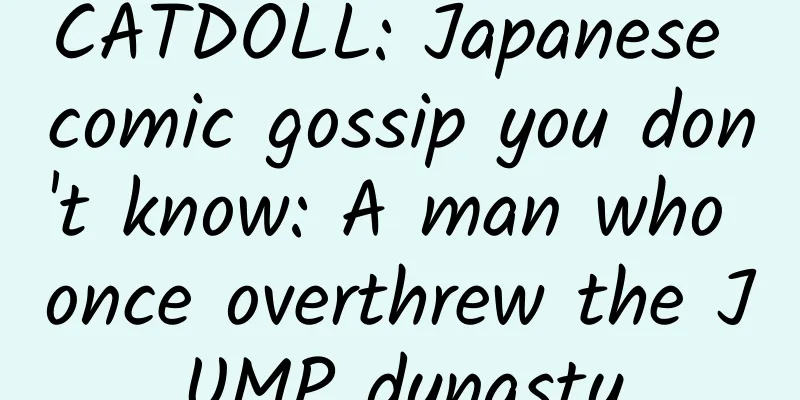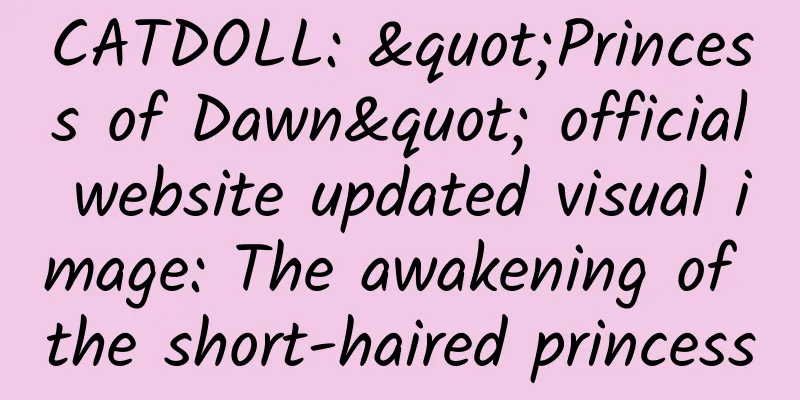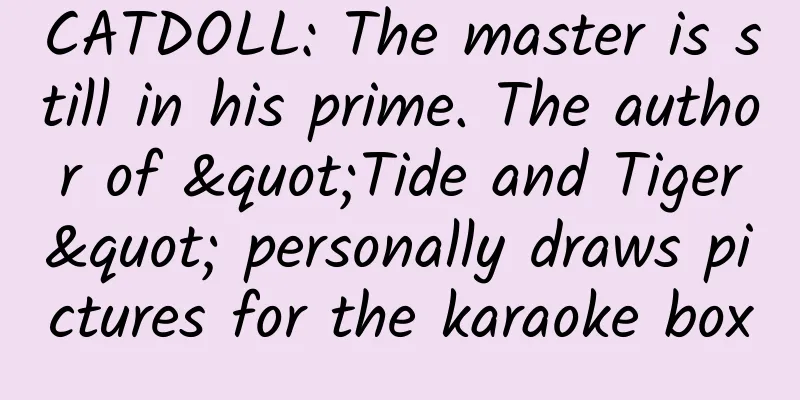CATDOLL: Japanese comic gossip you don't know: A man who once overthrew the JUMP dynasty

|
There are many classic works in the history of Japanese comics, and the Japanese comic publishing system has been formed for a long time. The competition between publishers is also very fierce. The quality and popularity of comics are not just about the comics themselves. So what are the inside stories behind the birth of these masterpieces? What kind of interesting stories are there behind the scenes? In fact, sometimes, this so-called "gossip" may be more interesting than the comics themselves. Let's take a look at the gossip we didn't know before. There was a man who single-handedly overthrew the entire JUMP dynasty, his name was Eikichi Onizuka! Related works: "GTO Hot Teacher" After a series of popular comics such as Dragon Ball were completed, JUMP and SUNDAY started fighting each other again, and both were preparing to launch the next big work to share the market. However, Shonen Magazine, which had been playing a supporting role since the formation of the comic publishing industry, finally got rid of the heavy soy sauce bottle and launched a comic that changed the entire history of the comic industry. In May 1997, Toru Fujisawa officially released his work GTO Hot Teacher. "GTO" tells the story of former biker party member Eikichi Onizuka who decided to take an interview for a substitute teacher in order to get close to high school girls, but later by chance he became an excellent teacher with his unique educational approach. In fact, this kind of plot seems to be extremely common in the current era when movies and TV shows are everywhere, but in the era of that time, "being a teacher for impure purposes" was a legal violation, and it was also a pleasing violation in terms of painting. With these two violations, coupled with the tearful, touching and deeply satirical plot of the Japanese education system, this comic became a hit. In the following years, it was continuously adapted into TV series, radio dramas, animations, etc., and its influence quickly swept across the country. Data shows that the TV series released in 1998 reached a terrifying viewership rate of 26%! GTO made MAGAZINE a success, and at the same time it pushed JUMP off the altar for the first time. In July 1997, MAGAZINE's sales exceeded JUMP for the first time, ending its 23-year dominance. Viper's comment: Today's "JUMP" is still the leader in the comics industry, and has been the champion for more than ten years, so remember this yellow-haired man, he has created an unprecedented miracle. The story of a godlike man who fell into disrepair and was kicked out of his home. Burn my little universe! Related works: "Saint Seiya" In those years, he was still a young man who still relied on editing to make a living, so when "JUMP" did not have any comics for women, he was forced to transform and draw a "Boxing Bet"; in those years, he was just a small character who drew short stories to fill the pages, weakly buried among many great gods. But in 1985, this man's little universe exploded, "Saint Seiya" was born and completely swept the comics continent and directly pushed "JUMP" to the first throne. In 1988, Masami Kurumada, who was very popular, created an incredible record. At the annual tax meeting, he paid 313.97 million and ranked first in Japan with "Saint Seiya"! At that time, Masami Kurumada was extremely proud. He could be ranked first in the country with just one comic. It was unprecedented and unparalleled. But history also began to turn from here. With the development of the plot and the progress of the times, "Saint Seiya", which had always only followed the routine of fighting monsters and upgrading, gradually lost its popularity. After all, readers would not like a cookie-cutter comic. Therefore, "Saint Seiya" was eventually forced to end and ended its glory in a not very decent way - it was forced to be completed in Monthly JUMP. In fact, the main reason why Masami Kurumada fell from the path of a super god to a stray dog kicked out of "JUMP" was entirely due to Masami Kurumada's own stubborn and single-minded way of thinking. In the later "Saint Seiya", he completely ignored the editor's suggestions and continued to use the old routines. Viper's comment: In the previous "Hades of the Underworld", Kurumada thought that "the voices of all voice actors except Toru Furuya who voiced Seiya have deteriorated", so he changed the voice actors and attracted negative reviews from all walks of life. Plagiarism? Imitation? A perfect copy that even FATE/Jue Ji can't touch Related works: "Yu Yu Hakusho", "Flame of Blaze" "Yu Yu Hakusho" is the famous work of Yoshihiro Togashi, and it is also a work he created seriously with the determination to surpass Toriyama Akira. It has to be said that this genius who is serious about his work does have strength that cannot be ignored, but the genius who always does not play by the rules chose to end "Yu Yu Hakusho" at the most exciting part, leaving the readers who have been chasing it with nowhere to run... So in order to snatch this group of confused people, as the sales of JUMP declined sharply, "Weekly Shonen Sunday" began to disrupt the situation with its long-planned pubic hair - in the magazine No. 16 in 1995, "Weekly Shonen Sunday" began to serialize the comic "Flame of Blaze", which staged a good show of "perfect copy" for the industry! This manga, whether in plot or character creation, clearly shows the shadow of "Yu Yu Hakusho". The male protagonist also has special abilities, the theme is also adventure and level-breaking, and some chapters are directly copied (the four sacred beasts, the demon world duel chapter), and the goal of the boss at the end is to open the channel to another dimension to destroy humanity... Of course, if you say that these evidences alone cannot prove that it is plagiarism! Yes, but the most critical and indefensible evidence is the four-person group with exactly the same character settings! The single-celled protagonist likes impulsiveness + the cold and beautiful boy (actually looks like a woman) + the big and strong tough guy who solves problems by brute force + the perfect female character. Of course, if it was just a simple plagiarism of "Flame of Blaze", it would not be so popular. The novel settings in the later period also added a lot of color to the work. Therefore, relying on similar themes, this good move made by "Shonen Sunday" successfully attracted most of the readers of "Yu Yu Hakusho". Viper's Comment: "Flame of Blaze" is the best move in the history of "Shonen Sunday". No one could tell it was plagiarized in the early stage, and everyone was used to it when it started to copy on a large scale later. It's brilliant! It's really brilliant! The most boring, plotless, and outrageous manga in history, but also extremely popular - "Kinnikuman" Related works: "Kinnikuman" If the plot of a comic can be summarized in one sentence: "The protagonist has been fighting in the ring since the first episode, winning one and then going down to the next one", would you be interested? I think 99% of people will not be interested in such a lullaby comic, and it is probably not very popular. But you may not imagine... There is such a miracle in the history of "Weekly Shonen Jump"! In 1979, Boiled Egg (yes, don't doubt your eyes, this Y is the name of this bird!) began to serialize a work called "Kinnikuman" which was a complete failure in terms of character setting and plot. Well, for an excellent comic, character setting is not a big problem, so let's ignore the deformed protagonist whose mouth is bigger than his face and take a look at the plot: the work is set in modern Japan, and the protagonist is a second-rate superman Kinnikuman Kinnikutaku who lives in Japan (Mr. Boiled Egg, how many years have you not eaten meat!), he will use friendship and hard work as weapons to fight aliens, big monsters, various supermen and Ultramen, and become good friends with each other after the fight... This is a very monotonous setting in itself, and what's even more crazy is that the comics, which had little plot left in the second half of the comics, have completely gone out of control... The comics have no logic, and they just defeat the enemy again and again, just like a ring battle. Unbelievable, right? It was such a comic, which was second only to Dragon Ball and Saint Seiya in popularity in JUMP at the time, and it can be regarded as one of the incredible things in the comics world... Don't ask me why because I don't know either. Viper's comment: From an objective point of view, the popularity of "Muscle Man" at the time was also due to the immature development of comics at that time, and it also benefited from the author's revolutionary innovation in fighting storyboards. The 10 years of the passionate masterpiece Dragon Ball dragged down two comic masters Related works: "Dragon Ball", "Ranma 1/2" Starting in 1991, JUMP surpassed 6 million sales under the leadership of the masterpiece "Dragon Ball". At that time, JUMP was invincible. But soon after, JUMP's sales fell sharply because of the announcement of the completion of its three pillars "Slam Dunk" and "Yu Yu Hakusho". So in order to compete for this piece of fat meat, a fierce competition began... You may have guessed it, this is the duel between Dragon Ball and Ranma 1/2, a contest between two great comics, Akira Toriyama and Rumiko Takahashi, and a game between Shueisha and Shogakukan behind them! At that time, these two comics were the only two super popular comics left, and being the work of great comics was an important tool for publishers to make money. So the dream that should have belonged to the cartoonists themselves has now become a weird situation where whoever kills the other first will make more money. In this battle, both sides used all their magic weapons to show off their influence: Dragon Ball adapted games, Ranma recorded records. Dragon Ball adapted radio dramas, Ranma made movies. In the end, when there was nothing else to compare, they began to compete in plots. Super Saiyan 123 and Ranma's third person appeared one after another, and the plots of the two masterpieces became as endless as the endless August. In the end, Akira Toriyama couldn't hold on any longer and announced the end of his work in 1995. Ranma barely lasted a year before also announcing its end. The result was a loss for both sides. After exhausting his energy and being severely injured, Akira Toriyama never produced another good work, and Rumiko Takahashi's Ranma was also abandoned by fans because of its declining quality in the later period. Viper's comment: Akira Toriyama: "How can I draw Goku now that he's number one on Earth?", Editor: "Then let him become number one in the universe!" Who can understand Toriyama's impulse to copy others at that time. |
<<: CATDOLL: One Piece is a must-see for Japanese college anime fans
Recommend
CATDOLL: Kyoto Animation will launch a new video project "Free!" It's really easy to make money from fujoshi
The popular anime "Free!" produced by K...
CATDOLL: Tanaka Romeo's new work "Outlaws' Paradise" is released, and Ma Junzhi is optimistic about it
Romeo Tanaka, a well-known light novelist in the ...
CATDOLL: "Ushio and Tora" animation episode 7 preview image: an adventure with an uncertain future
The seventh episode of the animation "Ushio ...
CATDOLL: My sister is not human! "I am" TV animation decided
The school love comedy manga "I am..." ...
CATDOLL: TV animation "Classroom Crisis" will be broadcast in July, main staff announced
The original TV animation "Classroom Crisis&...
CATDOLL: The manga "Chihayafuru" announced to be adapted into a live-action movie
The popular manga "Chihayafuru" has bee...
CATDOLL: Marvel & Disney respond to Iron Man armor copyright lawsuit
Iron Man is adapted from a classic story in Marve...
CATDOLL: Anime Starry Sky Evening News: "Death Note" movie becomes an action movie? "Cat Days" animation decided
Good evening, everyone. Let's take a look at ...
CATDOLL: Weird comics from Zone 11: "Cigar Holic" What's the point of having a girlfriend?
Do you still remember the animation "Human C...
CATDOLL: The movie version of "Beyond the Boundary: The Past" releases the "Promised Bonds" dance PV
The "past chapter" of the upcoming Japa...
CATDOLL: The production line-up of the animation "Komori I Can't Reject!" is revealed, and the music production is handled by Bilibili
The official website of the TV animation "Ko...
CATDOLL: TV animation "The Disappearance of Yuki-chan Nagato" promotional CM released
The new April anime "The Disappearance of Na...
CATDOLL: The main characters of the new anime "Girls' Number" in October 2016 are revealed
The new idol voice actor theme work "Girl Nu...
CATDOLL: High School DxD Season 3 Episode 4 Picture and Text Preview
High School DxD Season 3 Episode 4 Picture and Te...
CATDOLL: The spin-off manga of "The Street Where Only I Am Missing" will be serialized in July
The new January anime "The Town Where Only I...









